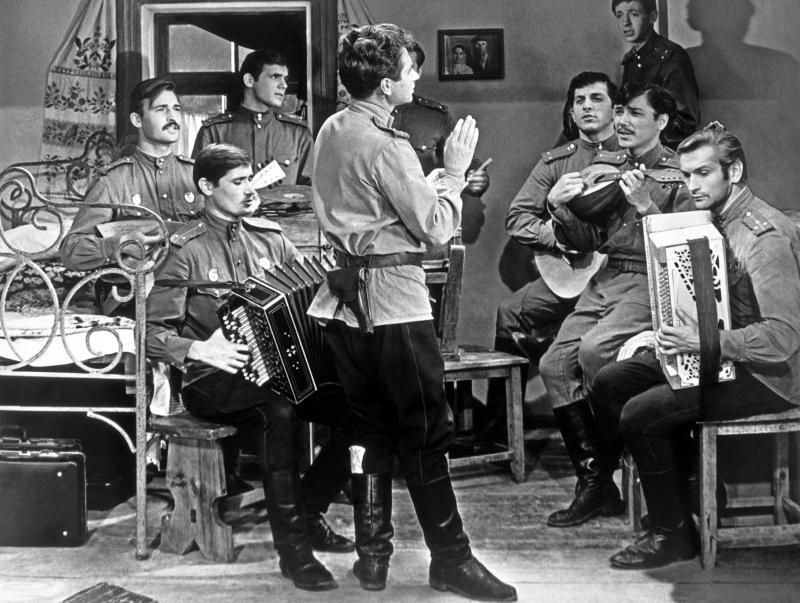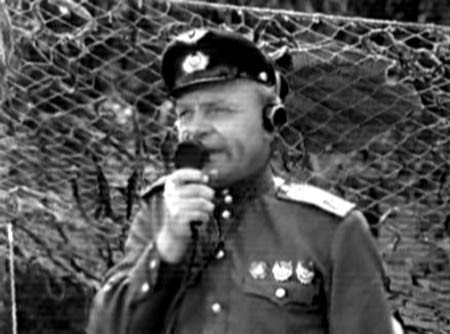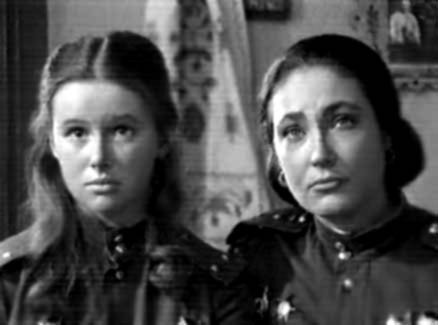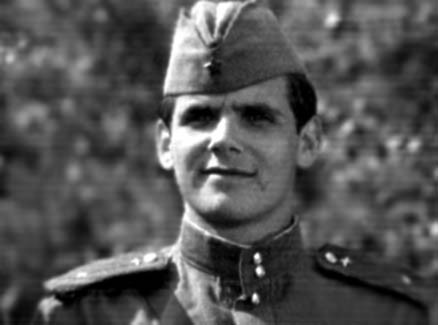В бой идут одни «старики»
| Year | 1973 |
|---|---|
| Country | USSR |
| Director | Леонид Быков |
| Cinematography | Владимир Войтенко |
| Scriptwriters | Леонид БыковЕвгений ОноприенкоАлександр Сацкий |
| Music | Виктор Шевченко |
| Art Direction | Георгий ПрокопецЛ. Коротенко |
| Editing | М. Зоровой |
| Genres | DramaComedyMilitary |
| Release Date | August 12, 1974 |
| Runtime | 87 min. |
Plot Summary
Did You Know?
Leonid Bykov was enrolled in flight school in 1945, but the small increase did not allow him to become a pilot.
The bulls realized their dream and have mastered control of the aircraft during the filming of the picture.
Singing squadron actually existed during the great Patriotic war.
A student of the theater Institute Eugene Simonov was filmed during the study on the set of her mother led.
State officials did not take long the screenplay, at the beginning of the picture for shots and committed only one plane. After the script of the film very much one of the marshals on site there were two aircraft.
In the role of "the dying Messer" shot down "Grasshopper" was used glider KAI-12 Primorets.
The story of the Hero of the Soviet Union hope of Popova and hero of the Soviet Union Semyon Kharlamov was the basis of the love line of the movie.
In 1967 Leonid Bykov was offered to direct the film about pilots screenplay by Vladimir Kunin "Chronicle of a diving bomber". However, he certainly wanted to include the song darkie that was firmly rejected in the Film. Your idea of the pilots singing "Darkie", Bulls embodied in the film "go To fight some "old men".
Takes attendance 61-th place among domestic films in the history of Soviet film distribution.
Leonid Bykov initially wanted to shoot the film in color. But color film, which was lying on the Studio Dovzhenko, was given only to the socialist realist films. Bykov said: if you shoot for the film on the tractor will give the color film. For a film about the war only gave the black-and-white.
The role of the Soviet fighters in the movie performing training aircraft Yak-18, the role of the Messerschmitt Czechoslovak aerobatic Zlin Z-326 Akrobat. The pilot was engaged in pilots DOSAAF. Real fighter aircraft during the second world war only appear on panels with newsreel.
For the role Darkie auditioned Vladimir Gerasimov.
The heroes of the film, captain Titarenko and mechanics in Makarych were monuments in Kyiv and Kharkiv respectively.
During operation, the Bulls have consulted with a large number of veterans, causing many characters have real prototypes. For example, the prototype squadron commander of the guard captain Titarenko became several people: twice hero of the Soviet Union Vitaly Popkov, hero of the Soviet Union Ivan Laveykin, and the name and call sign Titarenko "Maestro" was taken Bykov after he learned about Dmitry Titorenko slave three times Hero of the Soviet Union Ivan Kozhedub, the episodes from the biography which was included in the film. Also appeared in the scenario and Vano in memory of each front-line and first direct commander (the leading pair) Kozhedub at the front, the brave Georgian pilot Junior Lieutenant Vano Gabunia, who died heroically when a battering RAM German fighter Me-109.
It is believed that the prototype of the "Darkie became the Victor Sebranek, a childhood friend of Leonid Bykov, with whom he enrolled in flight school and who was killed in April 1945 during the liberation of Czechoslovakia.
The prototype Zoe became the hero of the Soviet Union Nadezhda Popova, Deputy squadron commander of the 46th guards regiment of female night bombers. The Dating scene with girls, when pilots are surprised to find that the more orders and medals than them, actually took place. Unlike her heroine, Nadezhda Popova went through the war and later married a hero of the Soviet Union Semyon Kharlamov, who made the chief consultant of the film.
In addition Titarenko, Vitaly Popkov became the prototype of the Lieutenant Alexandrov ("Grasshopper"). Future twice Hero of the Soviet Union, the commander was once suspended from flying for three months: pilot discharged excessively low turns over the airfield with the aim to show off in front of girls. The image Grasshopper was also borrowed episodes from the memoirs of twice Hero of the Soviet Union Sergei Lugansk "deep bends".
Many details of the script were taken from life. Drawing musical staff on the fuselage of the fighter "Maestro" was made by analogy with the Il-2 Vasily Emelianenko. Took place the tragic love story of an Uzbek pilot (real name Marichev) and a Russian girl (unlike her heroine, she wasn't a pilot and was killed in the bombing of the dining room), habit mechanics baptize before flying the aircraft, hit Maestro prisoner to his phrase "I would, commander, more Krauts knocked down, Yes, you have your underwear all the Krauts scared".
Veterans special private 434 th fighter regiment claimed that the film, when Titarenko returned to the regiment after the battle, not by plane and on horseback ("waved without looking!") taken from real life: at Stalingrad was shot down and came back at night on horseback, the pilot of their regiment Alexander Alexandrov. Similarly, veterans of the 1st guards air division told me that when the film shows how Titarenko detects camouflaged under haystacks German tanks, it refers to their comrade and commander hero of the Soviet Union guards major Stepan Bars.
The name of the film gave the tradition of pilots not to let immediately in a dogfight newly arrived replenishment, giving them a "bump" experience.
The finished script was rejected by the officials of the state of Ukraine as it was recognized as "unheroic". Then the Bulls began to read the individual pieces of the script while on tour in different cities of the Soviet Union. It has always been the audience enthusiasm, which convinced him in righteousness. Gradually, the script began to stand up the participants of the great Patriotic war. In particular, 14 November 1972 at the Studio Dovzhenko sent a letter to the chief of staff of military unit No. 55127 Colonel Lezzhov, who described the script as "an honest story about the war and about the people who got in her victory."
Bulls barely managed to approve the candidacy of Alexei Smirnov in the role of a mechanic Makaritch. The actor was known to the audience only as the actor of the Comedy genre, so officials refused to approve him for the role. In response, the Bulls announced that refuses to shoot the film, if it is not Smirnova, and spoke about the combat biographies of actor, participant of the great Patriotic war, the Chevalier of the three orders.
According to the original plan Bykov role she had to play by Leonid Filatov. Vladimir Talashko, in the end, plays the role of a slave Titarenko, later said that if it were so, then Bulls on the evening to silent, so as not to hurt colleague.
For the role of "Grasshopper" Bulls planned to invite Vladimir Konkin. Konkin took over the role of Grasshopper, but in that period he was busy in the film "How the steel was tempered"by Nikolai Mashchenko, and the Director wouldn't let him go on the shooting to the bulls.
Rustam Sagdullaev, who played Lieutenant Sagdullaev, aka "Romeo", he simultaneously starred in the film "My good man", for which the actor had to fly to Tashkent, where the shooting took place. For this reason, he spends most of the movie in the headset or the cap, so that his long hair needed for a different role, did not violate the authenticity of the image of the pilot during the great Patriotic war.
The film was the film debut of Evgenia Simonova.
In addition to directing and participating in the film, Bykov had to fight with the Directors picture. According to the memoirs of Roustam Sagdullaev, during the filming of the tape was replaced by three Directors, and each of them tried to disturb the working process. For example, forget the props, a secret from Bykov has withdrawn from filming the crowd or simply not doing their duties. The fact of the completion of filming Sagdullaev later called "a miracle".
Despite the enthusiastic reaction of the veterans (the premiere was visited by the pilots 8-th separate air defense army, which was commanded by hero of the Soviet Union, Colonel-General of aviation Vladimir Lavrinenkov), representatives of the Ministry of culture of Ukraine do not like the movie and was sent "on the shelf". Behind the tape stood up from the spectators and veterans, among whom was a member of the CPSU Central Committee, chief of the air force, air Chief Marshal hero of the Soviet Union Pavel Kutakhov. To stand up for the painting personally went to the reception to the Minister of culture of Ukraine and hero of the Soviet Union Lieutenant-General of aviation Vitaliy Popkov. The final decision to release the movie in wide release was made thanks to his success at the VII all-Union film festival where the film won two first prizes for best film and actor prize and a special prize from the Ministry of defence.
Largely because of the good reviews of ex-soldiers, who had to watch the movie before its release on the wide screen, the USSR state Committee for cinematography decided to promote premium pattern makers. Among the awarded was 39. At the award highlighted the Director Leonid Bykov: he paid 200 rubles prize and was awarded the title of "Director of the 1st category", while the actors Alexei Smirnov, Vladimir Talashko Sergei Ivanov paid 50 rubles. The leadership of the Dovzhenko film Studio considered the amount of remuneration is insufficient, but a petition before the state of the Union on the increase of honorarium to authors of the scenario with 6 thousand rubles to a maximum of 8 thousand left unsatisfied.
By 2009, the film was colorserver and restored, the military chronicle, the film was peeled from scratches and it also has color. When colorization nothing was removed and not added.







